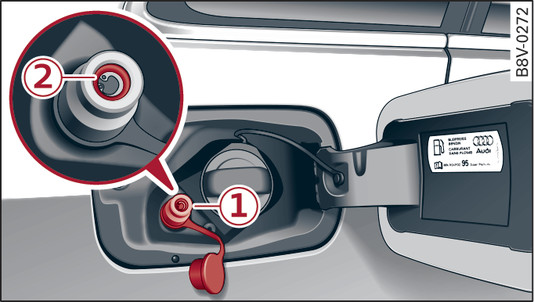|
Applies to: vehicles with natural gas engine
Vehicles with a natural gas engine have two fuel tanks: one for natural gas and one for petrol.
When refuelling with petrol, please note the additional information and warnings link►.
Switch off the engine, ignition and any mobile phones before refuelling ►.
Read and follow the instructions at the natural gas filling station. Before refuelling with natural gas, make sure that the correct type of fuel is used link►.
The fuel tank flap is unlocked and locked automatically by the central locking system.
Unscrewing the tank cap
The gas filler neck is behind the tank flap next to the petrol filler neck Fig. 111►.
Press the left side of the flap to open it -arrow- Fig. 110►.
Filling the tank
Pull the cap off the gas filler neck -1-.
Make sure that the seal -2- is securely seated in the gas filler neck.
Fit the coupling of the fuelling line onto the gas filler neck.
Lock the filler nozzle.
Start the refuelling procedure.
If you need to interrupt the fuelling procedure, press the stop button on the filler unit.
The compressor on the filler unit will be switched off automatically when the gas tanks are full.
Closing the tank cap
Unlock the filler nozzle.
Check that the seal on the gas filler neck -2- has not become stuck on the filler coupling.
If necessary, fit the seal back onto the gas filler neck.
Press the cap onto the gas filler neck.
Close the tank flap. Make sure you hear it click into place.
- Natural gas is highly explosive and highly inflammable. Improper use of natural gas can cause accidents, serious burns and other injuries.
- Make sure that the filler nozzle is correctly coupled with the gas filler neck before adding fuel. Stop fuelling immediately if you notice a gas odour.
The vehicle is not suitable for the use of hythane and must never be fuelled with hythane. Otherwise, serious damage to the engine and fuel system could result.
Note
- The procedure for operating the filler coupling can vary on different gas filler units. If you are unsure, ask a trained member of staff at the filling station to demonstrate the filling procedure.
- In very hot weather, the overheating protection system on the gas filler unit may automatically deactivate the fuelling system.
- The natural gas fuel system on the vehicle is suitable for refuelling both at domestic-type appliances using small compressors (time-fill) and at CNG filling stations using large compressors (fast-fill).


